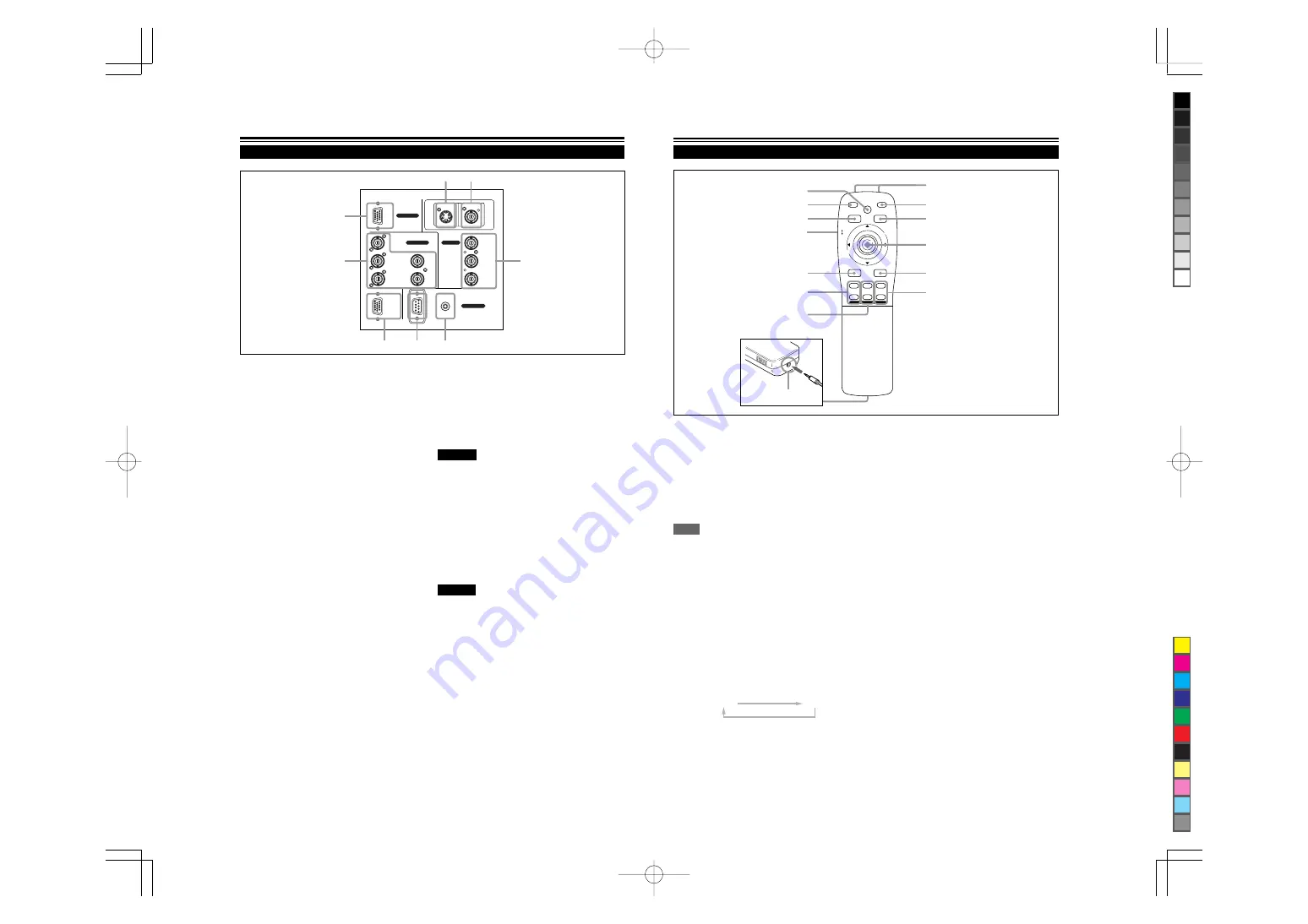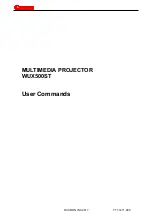
No.51666
DLA-M4000LU
DLA-M4000LE
10
Controls and Features (cont.)
Connector Panel
1
Y/C (S video) input terminal (Mini DIN 4 pin)
Connect this terminal to the S video output terminal of a
video deck, etc.
* This terminal can be used if a video board (PK-G1101D)
sold separately has been installed. The terminal was not
provided when the projector was shipped from the factory.
2
VIDEO (composite video) input terminal (BNC)
Connect this terminal to the composite video output terminal
of a video deck, etc.
* This terminal can be used if a video board (PK-G1101D)
sold separately has been installed. The terminal was not
provided when the projector was shipped from the factory.
3
Y, P
B
/B-Y, P
R
/R-Y input terminals (BNC)
These are input terminals for component (Y, B-Y, R-Y)
signals or DTV-format (Y, P
B
, P
R
) signals.
Device with component signal output terminals, such as
for NTSC and DTV-format, can be connected.
* For details about DTV-format signals (480i, 480p, 720p,
1080i) compatible with this unit, refer to page 66.
4
REMOTE terminal (mini jack)
This terminal is used to directly connect the remote con-
trol to the projector. Use the remote control cable supplied.
An infrared remote control extension unit can also be con-
nected to the jack.
5
RS-232C terminal (D-sub 9 pin)
This is a RS-232C interface-specified terminal. This
projector can be controlled by a computer connected
externally.
6
RGB OUT (RGB output) terminal (D-sub 3-row 15 pin)
The computer input signal projected on the screen is output.
A display unit can be used by connecting it to this terminal.
7
RGB IN (RGB input) -2 terminal (BNC)
These are input terminals for analog RGB signals, vertical
sync (V) signals, and horizontal sync (H) signals / composite
signals(Cs). Devices which have analog RGB signal output
terminals can be connected.
* Input of external sync signals is automatically
detected.
Detection of H/V signals or Cs signals causes automatic
switch to external sync. The priority order is H/V > Cs.
CAUTION
• When computer-related signals are input, the uppermost edge
of the screen may appear bowing if the sync signal input is
composite sync (Cs) or G on sync signal. In that case, use
separate sync signals for vertical sync (V) and horizontal sync
(H).
8
RGB IN (RGB input) -1 terminal (D-sub 3- row 15 pin)
This is an input terminal (PC) dedicated for computer
signals (RGB video signals and sync signals).
Connect the display output terminal of the computer to this
terminal. When a Macintosh or PC-9801/9802 series
computer is to be connected, use a suitable conversion
adapter separately available.
CAUTION
• When computer-related signals are input, the uppermost edge
of the screen may appear bowing if the sync signal input is
composite sync (Cs) or G on sync signal. In that case, use
separate sync signals for vertical sync (V) and horizontal sync
(H).
R
RGB
Y/C
VIDEO
G
H/C
S
B
V
P
R
/R-Y
P
B
/B-Y
Y
RGB OUT
RS-232C
REMOTE
RGB IN-2
CONTROL
EXT. IN
RGB IN-1
2
1
3
4
7
8
5
6
11
Controls and Features (Cont.)
Remote Control Unit
MEN
U/E
N
T
E
R
QUICK
ALIGN.
AV HIDE
OPERATE
PRESET
AV
SHIFT
ZOOM
FOCUS
LENS
U
T
+
D
W
–
RGB/COMPUTER
LENS
LOCK
UNLOCK
PAGE BACK
r
8
e
w
p
9
6
5
4
3
2
1
7
q
1
Remote control’s signal transmitter
2
OPERATE button
To turn on or off the power, press this button for one or
more seconds.
* About 30 seconds after the power has turned on, video
image will appear on the screen.
3
PAGE BACK button
While no menu is displayed, pressing this button causes a
direct channel to be displayed.
Memo
Direct channel display:
A direct channel display allows you to switch between chan-
nels which have lines and sources registered. For details,
refer to “Switching channels using a direct channel” (page
52).
4
MENU/ENTER button
Use this button to display the main menu, or while the main
menu is displayed, use the button to select an item to adjust
or make adjustment. While the main menu is displayed,
pressing MENU/ENTER displays a details setting
(submenu) if the selected item has a details setting.
For how to operate the buttons, see page 13.
5
RGB / COMPUTER button
Use this button to select the devices connected to the
projector’s RGB IN (RGB input) -1 and -2 input terminals.
Each time you press the button, the selection changes as
follows:
RGB 1
RGB 2
6
FOCUS (+/–) button
Use these buttons to adjust the focus of the projected
picture.
+: The focus point becomes more distant.
–: The focus point becomes nearer.
7
REMOTE terminal
Use a remote control cable to connect between the
projector and the remote control. For details, refer to
“Connecting to Devices which Control the Projector” on
page 22.
8
ZOOM (T/W) button
Use these buttons to increase or decrease the screen size.
(They can only be used when a zoom lens is used.)
T: The screen size decreases.
W: The screen size increases.
9
SHIFT (U/D) button
Use these buttons to adjust the height of the projection
screen when projectors are used in a stack configuration.
U: Moves the screen upwards.
D: Moves the screen downwards.





































